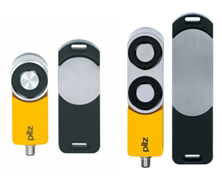
Posted to News on 21st Oct 2015, 17:35
Expanded range of guard interlocks offers greater versatility
For several years Pilz offered available 500N and 1000N guard locks (energise-to-lock) with built-in non-contact RFID interlocking for prevention of unexpected start up to PL e and SIL 3. Locking of the associated closed movable guard is done electromagnetically and the interlocking function is provided by detecting the guard position. In addition, the locking function includes monitoring of the electromagnetic force.

These devices have proven extremely popular in applications where there is a need to prevent an access guard from inadvertently being opened, which would otherwise result in unplanned machine downtime and an associated loss of production; for example, in food and drink manufacturing applications where a batch needs to be produced without interruption. Pilz says its PSENslock differs from other energise-to-lock guard switches in that there are no moving parts, just a solenoid and locking plate (with integral non-contact RFID elements) instead of the traditional solenoid switch body and tongue actuator, which is why they have an ingress protection rating of IP67. This fact, coupled with availability of stainless steel (VA) as an option, has made PSENslock devices very popular with end users and machine builders needing safety products that can be reliable even in wash-down environments. These interlocks have also found wider application in other production environments such as paint container filling and labelling machines, engine assembly lines, paper and paperboard production, and others.

The PSENslock also features clear LED diagnostics for confirming status (power, locked properly/defeated, safely closed with outputs on). Until recently the safe semiconductor outputs (rated PL e / SIL 3), also known as OSSDs, were designed only to energise when both the RFID circuit confirmed that the guard is closed and the solenoid is locked. This is a feature that has been welcomed by many, although the locking function itself is not a safe locking function (because it is energise-to-lock, and a loss of power will result in a loss of the locking function - therefore the lock provides process protection rather than personnel protection).
New models of PSENslock
In response to growing demand, Pilz has released new variants of the PSENslock switch body (compatible with the existing actuators) in which the OSSDs switch independently of the state of the lock, and only when the RFID circuit confirms that the guard is closed. This offers users of PSENslock devices even more flexibility.

According to Pilz, these two new options make the PSENslock probably the most flexible type of process solenoid locks with prevention of unexpected start up available today. It is predicted that sales of this type of technology will ramp up since the release of EN ISO 14119 and withdrawal of EN 1088 in May 2015, partly because of the use of RFID coding that allows designers and users to achieve high levels of prevention of defeat, and partly because the standard defines energise-to-lock devices like this for the first time and outlines their potential use in applications where protection of the process is a requirement (as opposed to protection of personnel). They are referred to as Interlocking device with electromagnetic guard locking device and the typical characteristics include: easy to clean due to sealing; high resistance to dusts and fluids; compact; no moving parts; and unlocking in case of power failure, depending on the design.
Secure fixings for interlocks

Furthermore, to complement the PSENslock, brackets are available to allow these interlocks to be used on sliding as well as hinged guards.
Follow the links for more information about PSENslock interlocks, PSENslock restart interlocks and mounting brackets and security fasteners.
Want the latest machine building news straight to your inbox? Become a MachineBuilding member for free today >>

















